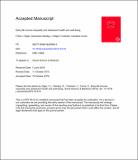Files in this item
Early-life income inequality and adolescent health and well-being
Item metadata
| dc.contributor.author | Elgar, Frank J. | |
| dc.contributor.author | Gariépy, Geneviève | |
| dc.contributor.author | Torsheim, Torbjørn | |
| dc.contributor.author | Currie, Candace | |
| dc.date.accessioned | 2017-10-17T23:33:08Z | |
| dc.date.available | 2017-10-17T23:33:08Z | |
| dc.date.issued | 2017-02 | |
| dc.identifier | 246903670 | |
| dc.identifier | 8be7aa62-8444-428c-a0a6-e6d59df7fc53 | |
| dc.identifier | 85008199824 | |
| dc.identifier | 000393931200024 | |
| dc.identifier.citation | Elgar , F J , Gariépy , G , Torsheim , T & Currie , C 2017 , ' Early-life income inequality and adolescent health and well-being ' , Social Science and Medicine , vol. 174 , pp. 197-208 . https://doi.org/10.1016/j.socscimed.2016.10.014 | en |
| dc.identifier.issn | 0277-9536 | |
| dc.identifier.other | RIS: urn:35011E403C3F7095183639F9F4B70180 | |
| dc.identifier.uri | https://hdl.handle.net/10023/11873 | |
| dc.description | The writing of this article was supported by grants from the Canadian Institutes of Health Research (MOP 235688) and Canada Research Chairs Programme awarded to the first author. | en |
| dc.description.abstract | A prevailing hypothesis about the association between income inequality and poor health is that inequality intensifies social hierarchies, increases stress, erodes social and material resources that support health, and subsequently harms health. However, the evidence in support of this hypothesis is limited by cross-sectional, ecological studies and a scarcity of developmental studies. To address this limitation, we used pooled, multilevel data from the Health Behaviour in School-aged Children study to examine lagged, cumulative, and trajectory associations between early-life income inequality and adolescent health and well-being. Psychosomatic symptoms and life satisfaction were assessed in surveys of 11- to 15-year-olds in 40 countries between 1994 and 2014. We linked these data to national Gini indices of income inequality for every life year from 1979 to 2014. The results showed that exposure to income inequality from 0 to 4 years predicted psychosomatic symptoms and lower life satisfaction in females after controlling lifetime mean income inequality, national per capita income, family affluence, age, and cohort and period effects. The cumulative income inequality exposure in infancy and childhood (i.e., average Gini index from birth to age 10) related to lower life satisfaction in female adolescents but not to symptoms. Finally, individual trajectories in early-life inequality (i.e., linear slopes in Gini indices from birth to 10 years) related to fewer symptoms and higher life satisfaction in females, indicating that earlier exposures mattered more to predicting health and wellbeing. No such associations with early-life income inequality were found in males. These results help to establish the antecedent-consequence conditions in the association between income inequality and health and suggest that both the magnitude and timing of income inequality in early life have developmental consequences that manifest in reduced health and well-being in adolescent girls. | |
| dc.format.extent | 894909 | |
| dc.language.iso | eng | |
| dc.relation.ispartof | Social Science and Medicine | en |
| dc.subject | Income inequality | en |
| dc.subject | Adolescents | en |
| dc.subject | Children | en |
| dc.subject | Health | en |
| dc.subject | Well-being | en |
| dc.subject | Health Behaviour in School-aged Children | en |
| dc.subject | Causal inference | en |
| dc.subject | H Social Sciences | en |
| dc.subject | RA Public aspects of medicine | en |
| dc.subject | 3rd-DAS | en |
| dc.subject | BDC | en |
| dc.subject | R2C | en |
| dc.subject | SDG 10 - Reduced Inequalities | en |
| dc.subject.lcc | H | en |
| dc.subject.lcc | RA | en |
| dc.title | Early-life income inequality and adolescent health and well-being | en |
| dc.type | Journal article | en |
| dc.contributor.institution | University of St Andrews. School of Medicine | en |
| dc.contributor.institution | University of St Andrews. WHO Collaborating Centre for International Child & Adolescent Health Policy | en |
| dc.contributor.institution | University of St Andrews. Child and Adolescent Health Research Unit | en |
| dc.identifier.doi | https://doi.org/10.1016/j.socscimed.2016.10.014 | |
| dc.description.status | Peer reviewed | en |
| dc.date.embargoedUntil | 2017-10-17 |
This item appears in the following Collection(s)
Items in the St Andrews Research Repository are protected by copyright, with all rights reserved, unless otherwise indicated.

